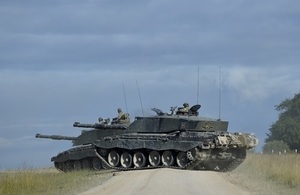Active Protection for our Armed Forces
Multi-million pound contract for assessment of active protection systems.

The Defence Science and Technology Laboratory (Dstl) has placed a £7.6 million contract with QinetiQ to evaluate an Active Protection System (APS) for armoured vehicles.
QinetiQ will work with a number of sub-contractors, including Airbus Defence and Space who are contracted to deliver, for evaluation, a number of systems based on the MUSS® self-protection systems. The technical assessments will quantify how well the system performs against a range of weapon systems, and will also include a BAE Systems appliqué integration of a MUSS® system onto a Challenger 2 Main Battle Tank to demonstrate potential future capability.
The MEDUSA Technical Assessment Programme (TAP) is a key part of on-going Dstl research into APS, alongside a complementary effort to develop the open architecture to support a future modular capability.
Dstl has been investigating APS for a number of years, and considers them an important part of a future survivability capability for keeping pace with new threats. A holistic view of survivability is required, drawing upon a range of technologies, which address all aspects from prevention of target detection to mitigation of potentially lethal effects. Active Protection defeats threats before they strike a vehicle, by sensing them and providing a ‘soft’ response (based on jamming or obscuration of the guidance mechanism) or ‘hard’ response (based on physical interception).
Dstl’s Heather Elsley says it could provide game-changing improvements for our Armed Forces:
These systems have the potential to improve the survivability and situational awareness, with an ability to minimise the weight growth that could impede the mobility of vehicles. This project is the first step on this path for Land Platforms - our ultimate aim is to provide a fully integrated, modular and layered system that can detect, track and defeat a wide range of threats, whilst assisting the vehicle crew by providing situational awareness and target cueing.
Andy Brownlow, Head of Business Development, Land Systems at QinetiQ, said:
We recognise the importance and future significance of a successful APS application in delivering battle-winning performance and protection for armoured vehicles across the UK vehicle equipment programmes. Our focus on MEDUSA is to assess capability, provide independent guidance and impart QinetiQ’s knowledge and experience across platform survivability, related sensor and effector technologies as well as the vehicle architecture domains to ensure we successfully deliver the potential game-changing improvements in capability for the Armed Forces.
QinetiQ is working closely with other industrial partners with APS domain expertise in order to conduct and deliver the MEDUSA TAP. Textron and Frazer-Nash are also key contributors to the MEDUSA team.
Brigadier Ian Gibb, Head of Combat Capability at Army Headquarters, Andover – says:
The Project Medusa contract is great news for the Army. The development of an effective Active Protection System would provide a hugely significant step change in the survivability of our platforms, particularly as we are reaching the technological limits of what passive armour can achieve. Initially, this capability is likely to have utility across all of our major battle-winning equipment programmes - Ajax, Warrior, Challenger 2 and the Mechanised Infantry Vehicle. But elements of APS should have applications across other platforms and systems too. We look forward to continuing to work alongside Dstl in this key project.
Dstl media enquiries
Email DstlPress@dstl.gov.uk
Press office 01980 950000 option 2